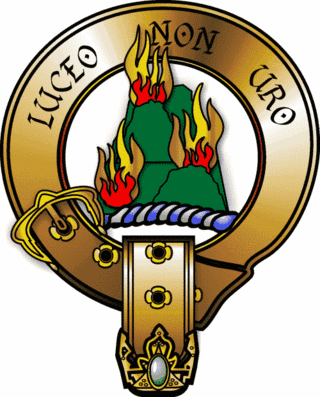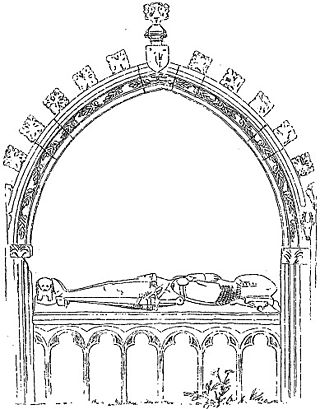Related Research Articles

Eilean Donan is a small tidal island situated at the confluence of three sea lochs in the western Highlands of Scotland, about 1 kilometre from the village of Dornie. It is connected to the mainland by a footbridge that was installed early in the 20th century and is dominated by a picturesque castle that frequently appears in photographs, film and television. The island's original castle was built in the thirteenth century; it became a stronghold of the Clan Mackenzie and their allies, the Clan MacRae. In response to the Mackenzies' involvement in the Jacobite rebellions early in the 18th century, government ships destroyed the castle in 1719. The present-day castle is Lieutenant-Colonel John Macrae-Gilstrap's 20th-century reconstruction of the old castle.

Clan Mackenzie is a Scottish clan, traditionally associated with Kintail and lands in Ross-shire in the Scottish Highlands. Traditional genealogies trace the ancestors of the Mackenzie chiefs to the 12th century. However, the earliest Mackenzie chief recorded by contemporary evidence is Alexander Mackenzie of Kintail who died some time after 1471. Traditionally, during the Wars of Scottish Independence, the Mackenzies supported Robert the Bruce, but feuded with the Earls of Ross in the latter part of the 14th century. During the 15th and 16th-centuries the Mackenzies feuded with the neighboring clans of Munro and MacDonald. In the 17th century the Mackenzie chief was made Earl of Seaforth in the peerage of Scotland. During the Scottish Civil War of the 17th century the Mackenzies largely supported the Royalists. During the Jacobite rising of 1715 the chief and clan of Mackenzie supported the Jacobite cause. However, during the Jacobite rising of 1745 the clan was divided with the chief, Kenneth Mackenzie, Lord Fortrose, supporting the British-Hanoverian Government and his relative, George Mackenzie, 3rd Earl of Cromartie, supporting the Jacobites.

The Clan Macrae is a Highland Scottish clan. The clan has no chief; it is therefore considered an armigerous clan.

Dingwall or Dingwell is a Scottish surname. One of the most prominent families by the name of Dingwall in Scotland were the Dingwalls of Kildun who were vassals of the Earl of Ross and also septs of the Clan Munro, a Scottish clan of the Scottish Highlands.
Donnchadh MacRath, also known as Duncan MacRae of Inverinate and Donnchadh nam Pìos, was a Scottish Gaelic poet and the compiler of the Fernaig manuscript which he committed to paper using an English-influenced system of orthography.
Kenneth Mackenzie, the first Lord Mackenzie of Kintail, was a Highland clan chief who secured for himself and his heirs the entirety of the Isle of Lewis in the Outer Hebrides and successfully pursued a bloody feud with the Macdonells of Glengarry.

Kenneth Mackenzie, 3rd Earl of Seaforth was a Highland clan chief and Scottish nobleman, who adhered faithfully to Charles II through his tribulations. From his great stature he was known among the Highlanders as "Coinneach Mor".
Alexander Mackenzie, known as "Ionraic", traditionally counted as 6th of Kintail, was the first chief of the Clan Mackenzie of whom indisputable contemporary documentary evidence survives. During his long life, he greatly expanded his clan's territories and influence.
Hector Roy Mackenzie of Gairloch was a Scottish clan chieftain of the Clan Mackenzie, who acquired vast estates in and around Gairloch, Wester Ross as a result of his services to the Scottish crown and challenged his nephew for the chiefship of the clan.
Colin Mackenzie of Kintail, nicknamed "Cam", was a Highland chief of the Scottish clan Mackenzie who greatly increased his ancestral estates through royal favour and a career of vigorous self-aggrandisement.
Kenneth Mackenzie, was the 10th laird of Kintail and he was nicknamed Coinneach na Cuirc in Scottish Gaelic, was a Highland chief, head of the Clan Mackenzie, who flourished in the turbulent Scottish politics of the mid-16th century.
The chiefs of the Scottish highland Clan Mackenzie were historically known as the Mackenzies of Kintail. By tradition the Mackenzie chiefs descend from Kenneth Mackenzie, 1st of Kintail however their earliest ancestor proven by contemporary evidence is Alexander Mackenzie, 6th of Kintail. The chiefly line became the Earls of Seaforth during the 17th century but this title was later forfeited in the 18th century due to support of the Jacobite rising of 1715. The current official chief of the Clan Mackenzie is John Ruaridh Grant Mackenzie, 5th Earl of Cromartie.

Kenneth Mackenzie, traditionally reckoned 7th of Kintail and nicknamed Coinneach a'bhlair, was a Highland chief, being head of the Clan Mackenzie.
Kenneth Mackenzie, or "Coinneach Oig", traditionally reckoned 8th of Kintail, was a Highland chief, being head of the Clan Mackenzie.
Fionnla Dubh mac Gillechriosd is purported to have been a 15th-century Scotsman, who lived in the north-west of Scotland. The Gaelic Fionnla Dubh mac Gillechriosd translates into English as "Fionnla the black, son of Gillechriosd". Fionnla Dubh is known from a late 17th-century traditional account of Clan Macrae; within that account he presented as a prominent ancestor of the clan. The tradition relates that for a time the chief of Clan Mackenzie was absent, and during that time his bastard uncles were causing trouble in the Mackenzies' territories of Kintail and Kinlochewe. Fionnla Dubh was then ordered to retrieve the chief and was successful in his task. From that time onward, says the tradition, the Macraes from the Kintail area rose in prominence amongst their Mackenzie lords. Tradition also states that Fionnla Dubh is an ancestor of the leading lines of the Macraes from Kintail.
Leod Macgilleandrais is purported to have been a 14th-century Scotsman who lived in the north-west of Scotland. He is known from clan traditions which date to the late 17th century. According to these traditions, Leod was a follower of the Earl of Ross, and that he was an enemy of the Mackenzies of Kintail. He is said to have captured one of the early Mackenzie chiefs, and was then later killed by the slain chief's son sometime in the 14th century. His memory is preserved in the place where he is said to have been slain. According to at least one version of the tradition, Leod was survived by a son named Paul. Several historians in 19th and early 20th centuries equated this son to Paul Mactire.
Lieutenant Colonel John MacRae-Gilstrap was a British army officer and a senior figure of the Clan Macrae. He contested a rival claim to the chiefship of the clan, and in 1912 he purchased and subsequently restored the Macrae stronghold of Eilean Donan Castle on Loch Duich in the west of Scotland.
Farquhar Macrae (1580-1662) was a Scottish minister in the parishes of Gairloch and Kintail, Ross and Cromarty. He is known for the cultural improvement he brought to the north of Scotland in the seventeenth century.

The Mackenzies of Gairloch were a minor noble Scottish family and one of the senior cadet branches of the Clan Mackenzie, a Scottish clan of the Scottish Highlands.

Murdo or Murdoch Mackenzie, also known as Murdo McRorie was a Scottish courtier and the builder of Fairburn Tower near Inverness.
References
- 1 2 3 4 5 Sir James Balfour Paul, The Scots Peerage, volume VII (David Douglas, Edinburgh, 1910), at pages 498-499
- ↑ MacCoinnich, A. (2003) "Kingis rabellis" to Cuidich 'n' Righ; the emergence of Clann Choinnich, c. 1475-1508. In: Boardman, S. and Ross, A. (eds) The Exercise of Power in Medieval Scotland, 1200-1500. Four Courts Press, Dublin, pp.175-200
- 1 2 3 4 5 6 7 Alexander Mackenzie, History of the Clan Mackenzie (A & W Mackenzie, Inverness, 1879), at pages 84-116